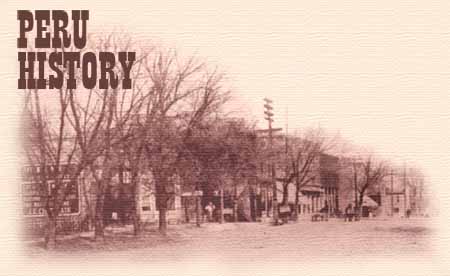|
Peru began at the river's edge.
It was the river that powered the sawmills and the grist mill; it was
the river that facilitated the movement of supplies and products. In
fact, Peru's first enterprise was a ferry boat which made its initial
trips across the Missouri in early 1855.
Claim cabins had been erected as early as 1853 in the area that later
became Peru, soon to be followed by others. A. M. Medley wrote, "My
father, A. Medley and family settled on Honey Creek in what is now Peru
precinct in April, 1855. He was a blacksmith by trade and soon opened a
shop for accommodation of other settlers. A store and post office were
started, and schoolhouse built in 1855."
Mt. Vernon town site was platted and a post office secured. Two years
later, in 1857, a survey was made laying out Peru, and though there was
spasmodic talk of uniting the two towns, Peru forged ahead and Mt.
Vernon eventually disappeared.
D. C. Cole wrote, "The winter of 1856-57, known as the winter of the
deep snow, saw a great deal of suffering. Times were hard, food scarce,
settlers few and far between, no mills from which to get flour or stores
to buy the other necessities of life, and but little money with which to
buy; what marketing was done, was done in Missouri. All were poor, but
endured the hardships that their children might be benefited thereby."
However, among those arriving to settle the new region, was Samuel
Dailey who in 1857 brought machinery for a sawmill. He and Major Baker,
Indian Agent at the Otoe Reservation, and Thomas Green, a daring pioneer
businessman, built a sawmill by the river. A flour mill was added, but
the machinery was barely saved when the river swallowed the mill
structure, lumber and log yard. Tom Green then installed the saw
machinery on the other side of the river, and went on in 1862 to erect a
flour mill at Peru with lumber hauled across the ice. This mill, Green's
flour mill, became a center of industry for the entire area, and
contributed immeasurably to the development of the town.
The hills along the river were covered with thick stands of trees, and
soon the sawmills were turning out the lumber so imperatively demanded
by the new country, to build houses and barns, schools, churches and
stores. Steamboats plying up and down the river needed constant supplies
of wood for fuel. These boats brought grain to Peru's grist mill from
other towns along the river, and farmers from miles around drove in with
wagons loaded with wheat, all to be ground into flour at Green's mill.
Another early industry, important to Peru's history, was the
brick-making business. Clay from a nearby hill proved suitable for brick
making, and soon a brickyard with horse-powered mill, and a brick kiln
were turning out high grade building material. This industry flourished
for about forty years, and its products may still be seen in buildings
in the area.
The coming of the railroad to Peru in 1875 marked the end of the era of
steam boating. The bulk of freight was moved by the railroads, and boats
came more and more infrequently. Eventually the river left the town, and
was no longer a part of Peru's daily life. But the town shifted its
emphasis to the college that had been established on her southern edge.
This college, born in 1865 through individual donations, held its first
classes in an abandoned building in 1866 with thirty-six students. It
first was a Normal school, later becoming a Teachers' College, and now
is known as Peru State College. In 1966-67 the college with twenty fine
buildings on its beautiful campus, the "Campus of a Thousand Oaks",
celebrates its centennial year. Other publications in this connection
recount details of its history. We quote briefly from one.
"The image of an institution sometimes is measured by its physical
facilities and the fortunes of its athletic teams. Important as these
may be, Peru State is primarily concerned with the quality of her
productóthe young people who will take their places in society in a
myriad of capacities."
Undeniably the existence of this fine college has had tremendous impact
in many ways, not only on the town of Peru, but on the entire county.
The town now has four churches, a grocery store, post office, bank
(established in 1891), two restaurants, coin laundry and dry cleaning
establishment, Kiwanis Club, Masonic Lodge, and O.E.S.
The steamboat whistle no longer echoes from the hills. The mills and
warehouses, the brickyard, the landing docks are gone. But Peru has
adapted to change, and faces the future with optimism.
‘ |

